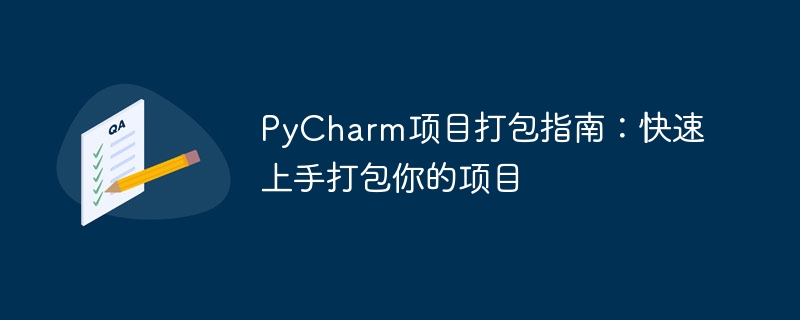

PyCharm Project Packaging Guide: Quickly start packaging your project
Introduction:
In the software development process, packaging is to integrate code and resource files into One of the important steps in executing files or publishing packages. Packaging makes it easy to share projects with others, and also helps with project deployment and maintenance. As a powerful Python IDE, PyCharm provides convenient and fast project packaging functions. This article will introduce you how to use PyCharm to package Python projects, and attach specific code examples to help you get started quickly.
1. Preparation:
Before you start packaging the project, you need to ensure that you have installed PyCharm and successfully created a Python project. At the same time, you need to install the following tools:
pip install setuptools command in the terminal. to install. pip install wheel command in the terminal to install. 2. Create the setup.py file:
setup.py is the core file of project packaging, which contains packaging-related configuration information. Create a new file in PyCharm, name it setup.py, and copy the following code into the file:
from setuptools import setup, find_packages
setup(
name='YourPackageName',
version='1.0.0',
packages=find_packages(),
url='https://github.com/YourUsername/YourPackageName',
license='MIT',
author='YourName',
author_email='yourname@example.com',
description='A brief description of your package',
install_requires=[
'numpy',
'pandas',
],
)In the above code, you need to modify the name according to the actual situation Fields such as , version, url, author, author_email, and description, as well as according to project needs Add dependencies to the install_requires list.
3. Execute the packaging command:
In the Terminal of PyCharm, execute the packaging operation by running the python setup.py sdist bdist_wheel command. This command will generate a dist directory in the project root directory and contain the packaged content.
4. Verify the packaging result:
In the dist directory, you can find a file ending with .tar.gz or .whl suffix, this is your packaged project. You can share the file with others or deploy it to other environments. At the same time, you can also install and verify the packaging results by executing the pip install dist/YourPackageName-1.0.0.tar.gz (or .whl) command in PyCharm's Terminal.
Code example:
To help you better understand the packaging process, we provide a simple code example. Suppose your project has a module named utils.py, which contains a function named add, which is used to add two numbers. The following code demonstrates how to package the project.
# utils.py
def add(a, b):
return a + bIn the project root directory, create a setup.py file and copy the previously mentioned code. Then run the python setup.py sdist bdist_wheel command to package.
After successful packaging, you can find the generated files in the dist directory. Assuming the file is named YourPackageName-1.0.0.tar.gz, you can now distribute or install the project.
This is a simple example, you can perform more complex packaging operations according to the needs of actual projects.
Summary:
This article briefly introduces how to use PyCharm to package Python projects, and provides specific code examples to help you get started quickly. Through packaging, you can easily share and deploy projects, further improving the efficiency of development and maintenance. I hope this article was helpful and good luck with your packing!
The above is the detailed content of Project packaging guide: Use PyCharm to quickly package your project. For more information, please follow other related articles on the PHP Chinese website!
 How to change pycharm to Chinese
How to change pycharm to Chinese
 pycharm installation tutorial
pycharm installation tutorial
 How to solve the problem that pycharm cannot find the module
How to solve the problem that pycharm cannot find the module
 How to install pycharm
How to install pycharm
 The difference between python and pycharm
The difference between python and pycharm
 How to configure the pycharm environment
How to configure the pycharm environment
 How to install the pycharm interpreter
How to install the pycharm interpreter
 What does pycharm mean when running in parallel?
What does pycharm mean when running in parallel?




